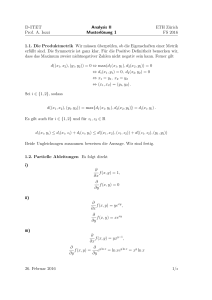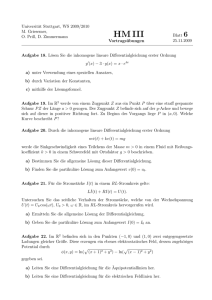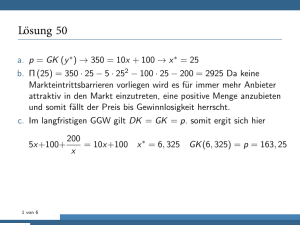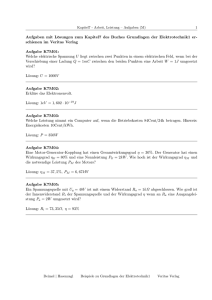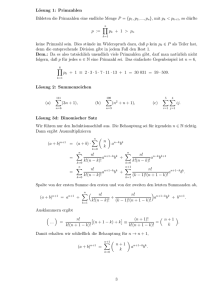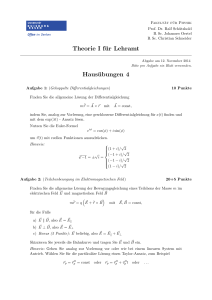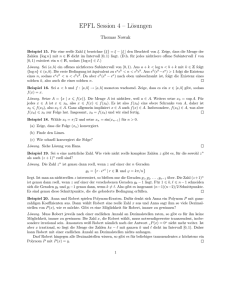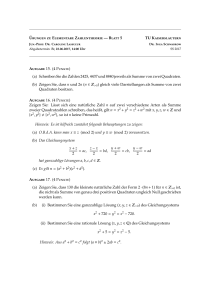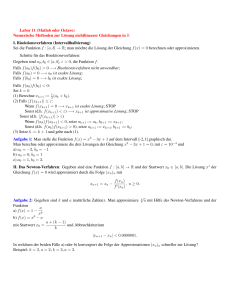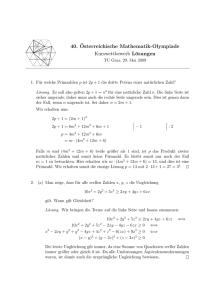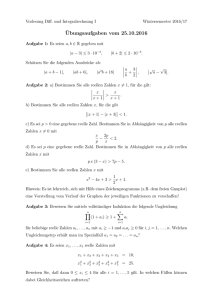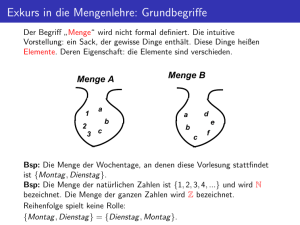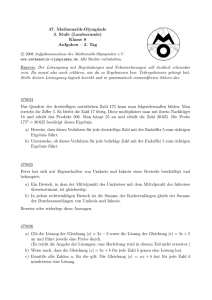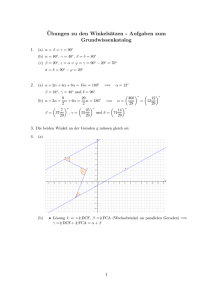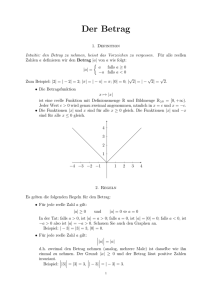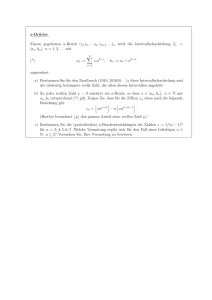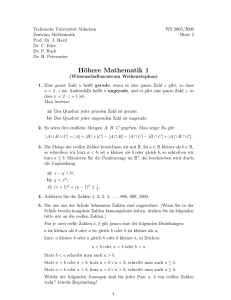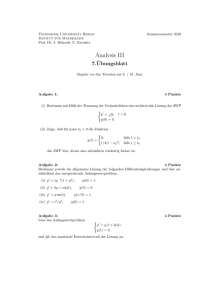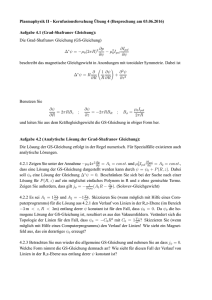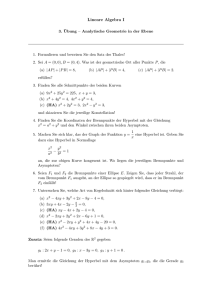Ubungsblatt 0 Höhere Mathematik I WS 2010/2011
Werbung
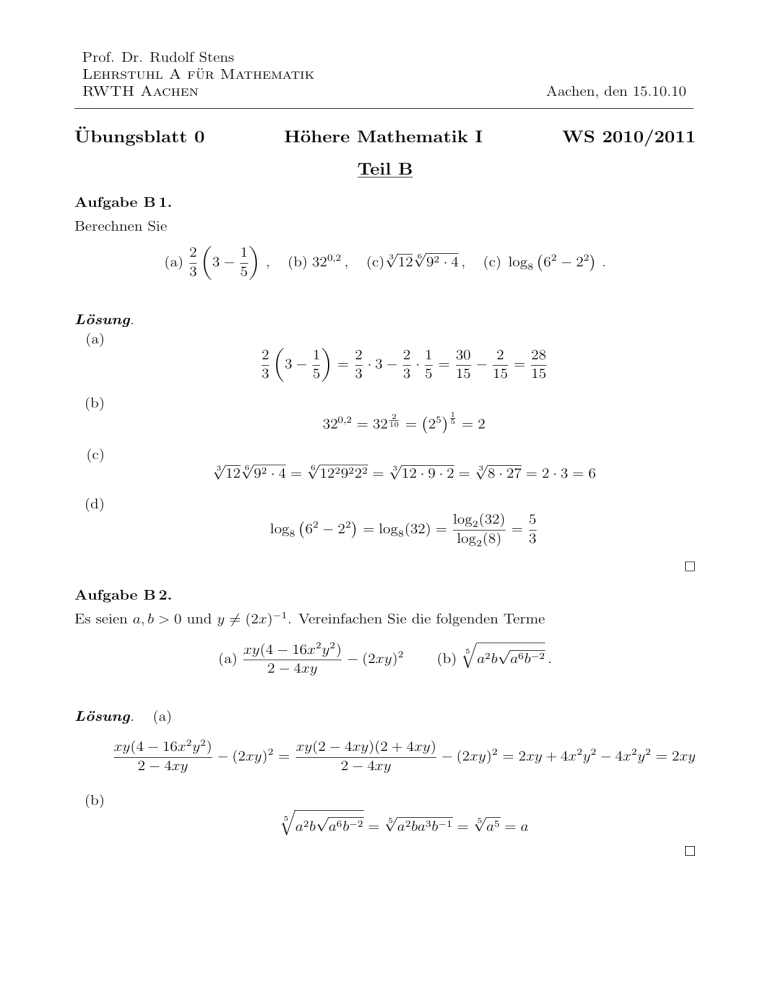
Prof. Dr. Rudolf Stens
Lehrstuhl A für Mathematik
RWTH Aachen
Übungsblatt 0
Aachen, den 15.10.10
Höhere Mathematik I
WS 2010/2011
Teil B
Aufgabe B 1.
Berechnen Sie
2
(a)
3
1
3−
,
5
(b) 320,2 ,
√
√
6
3
(c) 12 92 · 4 ,
(c) log8 62 − 22 .
Lösung.
(a)
2
3
1
2
2 1
30
2
28
3−
= ·3− · =
−
=
5
3
3 5
15 15
15
(b)
2
320,2 = 32 10 = 25
(c)
√
3
51
=2
√
√
√
√
6
6
3
3
12 92 · 4 = 122 92 22 = 12 · 9 · 2 = 8 · 27 = 2 · 3 = 6
(d)
log2 (32)
5
log8 62 − 22 = log8 (32) =
=
log2 (8)
3
Aufgabe B 2.
Es seien a, b > 0 und y 6= (2x)−1 . Vereinfachen Sie die folgenden Terme
q
√
5
xy(4 − 16x2 y 2 )
2
− (2xy)
(b) a2 b a6 b−2 .
(a)
2 − 4xy
Lösung.
(a)
xy(4 − 16x2 y 2 )
xy(2 − 4xy)(2 + 4xy)
− (2xy)2 =
− (2xy)2 = 2xy + 4x2 y 2 − 4x2 y 2 = 2xy
2 − 4xy
2 − 4xy
(b)
q
5
√
√
√
5
5
a2 b a6 b−2 = a2 ba3 b−1 = a5 = a
Aufgabe B 3.
Lösen Sie die folgenden (Un-)Gleichungen:
(a) x2 + 5x + 7 = 0
(b) x3 + x2 − x − 1 = 0
|2x − 1|
≤1
(d)
|2 − x|
(c) (x + 5)(x − 4) ≤ 0
Lösung.
(a)
⇔
x2 + 5x + 7 = 0
2
3
5
=−
x+
2
4
Die Lösungsmenge (als Teilmenge der reellen Zahlen) ist also leer, d.h. L = ∅.
(b)
x3 + x2 − x − 1
=0
⇔ x2 (x + 1) − (x + 1) = 0
⇔ (x2 − 1)(x + 1)
=0
2
⇔ (x − 1)(x + 1)
=0
Also L = {−1, 1}.
(c)
(x + 5)(x − 4) ≤ 0
⇔ [x + 5 ≤ 0 ∧ x − 4 ≥ 0] ∨ [x + 5 ≥ 0 ∧ x − 4 ≤ 0]
⇔ [x ≤ −5 ∧ x ≥ 4] ∨ [x ≥ −5 ∧ x ≤ 4]
⇒ −5≤x≤4
Damit ist L = [−5, 4]
(d) Fallunterscheidung!
1.Fall: Es gelte: 2x − 1 ≥ 0 und 2 − x > 0
Also ist 21 ≤ x < 2. Dann gilt
|2x − 1|
2x − 1
≤1 ⇔
≤ 1 ⇔ 2x − 1 ≤ 2 − x ⇔ x ≤ 1
|2 − x|
2−x
In diesem Fall also L1 = 12 , 1 .
2.Fall: Es gelte x > 2. Dann ist
2x − 1
|2x − 1|
≤1 ⇔
≤ 1 ⇔ 2x − 1 ≤ x − 2 ⇔ x ≤ −1
|2 − x|
x−2
Dies ist ein Widerspruch zur Voraussetzung x > 2. Also L2 = ∅.
3.Fall: Es gelte x ≤ 12 . Dann ist
|2x − 1|
1 − 2x
≤1 ⇔
≤ 1 ⇔ 1 − 2x ≤ 2 − x ⇔ x ≥ −1
|2 − x|
2−x
In diesem Fall ist also L3 = −1, 12 .
Insgesamt ist L = [−1, 1].
Aufgabe B 4.
Vervollständigen Sie die Wahrheitstafel.
Lösung.
A B ¬A A ∧ B
W W F
W
W F
F
F
F W W
F
F F W
F
A∨B
W
W
W
F
A⇒B
W
F
W
W
A⇔B
W
F
F
W
(¬B) ⇒ (¬A) A ∧ (¬B) (¬A) ∨ B
W
F
W
F
W
F
W
F
W
W
F
W
Aufgabe B 5.
Beschreiben Sie die folgende Aussage formal, d.h. insbes. unter Verwendung von Quantoren:
“Für jedes positive, reelle ε existiert ein positives reelles δ, so dass für alle reellen Zahlen x,
welche einen Abstand kleiner als δ zu der reellen Zahl x0 besitzen, gilt, dass f (x) einen Abstand
von weniger als ε zu f (x0 ) besitzt.”
Lösung. ∀ ε > 0 ∃ δ > 0 so dass ∀ x ∈ R mit |x − x0 | < δ gilt: |f (x) − f (x0 )| < ε.
Aufgabe B 6.
Formalisieren Sie die folgenden Aussagen durch einen logischen Ausdruck und bestimmen Sie
ihre jeweilige logische Negation. Welcher der Aussagen sind richtig? Begründen Sie!
(a) Für jede reelle Zahl x gibt es eine natürliche Zahl n, so dass x < n gilt.
(b) Es gibt eine natürliche Zahl n, so dass für jede reelle Zahl x die Ungleichung x < n gilt.
Lösung.
(a) ∀ x ∈ R ∃ n ∈ N mit x < n. Dies ist wahr. Wähle z.B. n = dxe + 1.
Negation: ∃ x ∈ R so dass ∀n ∈ N gilt x ≥ n. (falsch!)
(b) ∃ n ∈ N so dass ∀ x ∈ R gilt x < n. (falsch)
Negation: ∀ n ∈ N ∃ x ∈ R so dass x ≥ n. Dies ist wahr. Wähle z.B. x = n + 1.
